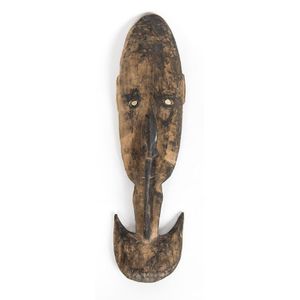Sepik River Ancestral Carving with Hornbill Surmount
You must be a subscriber, and be logged in to view price and dealer details.
Subscribe Now to view actual auction price for this item
When you subscribe, you have the option of setting the currency in which to display prices to $Au, $US, $NZ or Stg.
- Hornbill - Oriental antique descriptions occasionally refer to "hornbill" or "hornbill ivory" as the material from which the object is made. In fact the hornbill is a large bird, the helmeted hornbill, found in a few South-East Asian countries, and the name is also applied to the material obtained from a growth on the upper section of the beak of the bird, known as a casque.
In its natural form it is a yellow colour, but when the hornbill rubs its beak while preening its feathers, the growth turns a red colour.
As well as being used as a carving material in areas where the bird is found, hornbill became popular as a carving medium with the Chinese in the 19th century, and it was prized (and priced) ahead of ivory and jade.
The helmeted hornbill is listed in Appendix 1 of CITES, (Convention on International Trade in Endangered Species) meaning that trade in hornbill objects requires import and export permits.
the s natural ivory from the bird, native to Indonesia. The hornbill is now an endangered species, but due to the apparent age of the jewelry, this item would be legal for trade. Hornbill ivory is not a true ivory as it is not a dentine material, but rather a keratin. Hornbill ivory of this nature was often carved from the lower layer of the hornbill casque for the western market. The upper area, with a strong red coloration, was traded to the Eastern market. The upper areas of these pieces yet show some of the red coloring. The rest is in the strong yellowish color of natural hornbill. - A/f, as Inspected - The letters "A/F" or "as inspected" as part of a description is the cataloguer's shorthand for "all faults" or "as found", meaning the item has some type of damage or deficiency, it is of uncertain date or provenance, and/or that the seller takes no responsibility for the completeness of the item or the accuracy of the description.
This item has been included into following indexes:
Visually similar items

A Papuan New Guinea food hook;carved wood,shell inlay and rattan;43.5 cm high

Hair Bonnett, approx 18th century Holy Roman Empire embroided in raised gold

A Chinese cast-iron ' suanni ' incense burner, the mythical beast slightly leaning back, eyes looking up, its head unhinged, 15.1 cm high. Provenance: private collection NSW Note: suanni is a mytical beast that looks like a lion and said to be one of drago

A mabe pearl brooch, the finely crafted fish, set with a mabe pearl body, in textured and matt finish in 18ct gold.
